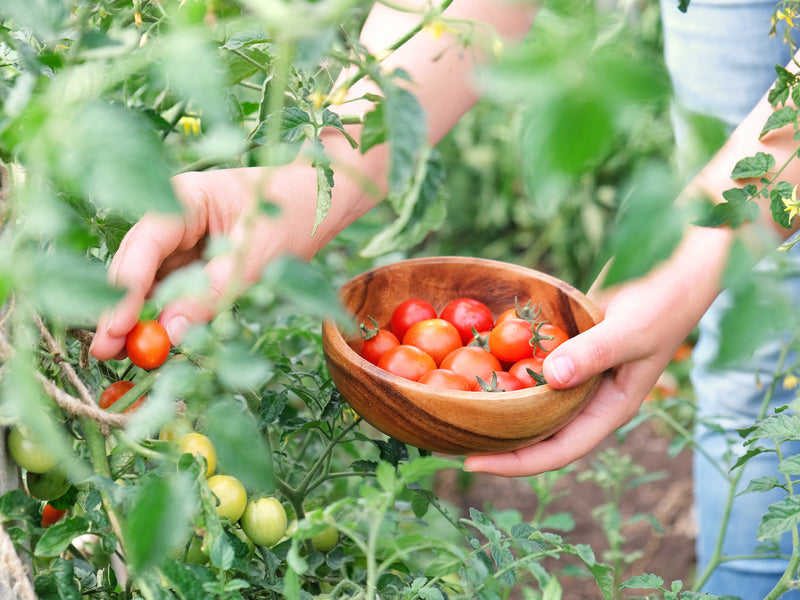Lettuce is a quick growing, cool-weather crop that is a staple in our home garden. There are many different varieties, but they generally all have similar needs and the only difference falls in how they are harvested. Below is our simple guide to growing lettuce from seeds:
PLANTING
Start indoors in small 4 inch pots in a cool location no hotter than 70 degrees (NOTE: lettuce seed can enter thermal dormancy when exposed to high temperatures) . Sprinkle only 4-5 seeds spaced evenly per pot over seed-starting, moist soil, then barely cover the seeds with a light sprinkling of soil (do not pack).
SOIL
Use seed starting organic potting mix or Spade To Fork organic soil disks. Soil should be loose and moist, never hard packed.
WATER
2-3 oz per watering, or less per pot. Allow the top 1/2’ of soil to dry slightly between waterings. DO NOT over-water or white fuzz (fungus) will grow on pots and soil.
AIR
Keep seedlings in a well-ventilated room or use a small fan to increase airflow
SUNLIGHT
6-8 hours per day of direct sunlight, or 12-16 hours per day grow lights
TEMPERATURE
45-70 degrees (60-68 degrees is best for sprouting). NOTE: lettuce seed can enter thermal dormancy when exposed to high temperatures
GERMINATION
10-14 days to see sprouts
THINNING
Each full grown lettuce head requires 8-10” of space. Thin seedlings to the amount of lettuce you have room to grow upon transplanting. Thin by cutting off at soil level with scissors being careful not to disturb the roots of the remaining seedlings.
FERTILIZING
No fertilizer needed until transplant. Then once every month lightly top dress soil with organic fertilizer and water thoroughly. We recommend using our Organic Starter & Transplanter fertilizer.
TRANSITIONING TO OUTDOORS
When seedlings are 3-4 weeks old and outside temperatures are between 45-70˚, begin hardening off your lettuce plants. Hardening off is the 1 week process of moving plants outdoors for part of each day to gradually introduce them to direct sunlight, dry or moist air, and cooler nights.
PLANTING LOCATION
Choose an outdoor location that receives 6-8 hours of direct sunlight, or for hot climates plant in semi-shade. If planting into a container, choose one that is minimally 12” wide x 12” deep with good drainage.
PREPARING THE SOIL
If planting in a garden plot, read this article on how to prepare the soil.
If planting in a raised bed, read this article on how to prepare the soil.
TRANSPLANTING
Best time of day to transplant is early in the morning, late in the afternoon or on a cloudy day.
Water seedlings 2 hours before transplanting.
In your outdoor garden space, dig holes 6 inches apart for each lettuce seedling you are planting.
Gently remove seedlings from the peat pot by squeezing the sides to help loosen and separate. Set lettuce transplants into the prepared soil 6” apart and lightly firm the soil around them.
Continue to fertilize monthly during the growing season. Keep soil evenly moist for best growing.
HARVESTING
For loose leaf lettuce or head lettuce that you'd like to enjoy over a longer period of time, snip outer leaves allowing younger leaves at the center to continue growing for later use. This method is called cut-and-come-again and allows the plant to live longer and produce more leaves. Continue harvesting each time the outer leaves grow to full size.
If harvesting the whole head of butterhead lettuce or similar small headed lettuces, do so when leaves begin to cup inward and form a rosette about 6 inches in diameter.
If harvesting the whole head of romaine lettuce, do so when leaves begin to cup inward and the plant is between 5-9” in height.
To harvest a whole head, pull the entire plant out of the ground or cut the base of the plant at ground level.
STORING YOUR HARVEST
Lettuce will keep in the refrigerator for 1-2 weeks. Rinse lettuce in cold water then dry. Wrap in a paper towel and keep inside an airtight bag or container in the refrigerator.













